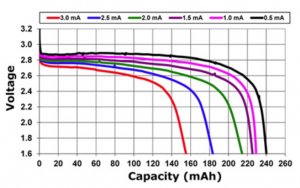CR2032
以 CR2032 爲例,它的規格容量是 225mAh,如果用 1mA 放電,大概可以放 225 個小時沒有問題。但如果用更大的電流放電,因爲電池内阻造成的損耗,它其實沒辦法供應這麽多的電。如果用 CR2032 的最大容許放電電流 3mA 來放電,它大概只能撐 50 小時上下,換算成容量大概只有 150mAh。那其它 75mAh 的能量跑到哪去了?答案是在電池的内阻上消耗掉了,變成熱,也造成了那麽一點點的全球暖化。
Enlarge the discharage
- I did my PhD thesis on energy management in wireless sensor networks and was working with sensor nodes using CR2032 batteries. We designed the nodes ourselves (my supervisor designed the PCB and I designed the firmware and all the energy-related testing).
- I can confirm what people above say that you can draw 100mA peaks from a new CR2032 cell. But as they say, to get the nominal capacity in terms of mAh you need to discharge it at the specified nominal current and temperature.
- The sensor nodes I was working on drew some 27-35mA on transmission. But transmissions lasted for 110-140ms at a time, once each minute. At room temperature using a single CR2032 in parallel with a 75mF supercap from CapXX we managed to use some 87% of the rated capacity of the CR2032 (the tested nodes were in function on average 99days). We used a CR2032 from Renata. The same setup without a supercapacitor would get roughly 10-15 days less of functional time on average. However, the supercap becomes crucial if you decide to go down in operating temperature!!! (which we did in tests to -30°C)
- The consequences of discharging with higher current are that you manage to get less energy than specified from the battery. The current peaks create voltage drops and at the moment when that voltage drop goes below your brown-out voltage - your circuit resets. Needless to say at that point there is still some energy left in the cell. To aleviate this problem you could add a supercapacitor to flatten out the transmission current peaks (voltage drops).
- But:
- supercapacitors are expensive
- you need one with low leakage current and balance circuitry such as from CapXX (they have leakage currents in the range of 1-2uA)
- A high leakage current supecapacitor will do more harm than good if the device needs to be powered for days or weeks.
- Also do not hesitate to connect CR2032s in parallel if you need to and you have space - you basically double the current capacity.
- Having said that - there is still a ton of work to be done in this world to improve energy management in such applications.
- Thanks for detailing. Here if i connect big value Tantulam Cap of 47uF across the battery, does that mean that Capacitor can be the Power Source during BLE communication as it will get discharge during BLE advertisment providing current, i have read somewhere. if so we can able to minimise the power or not ? – Viral Embedded May 18 '16 at 10:01
- 1
- lowtech talked about supercaps in the range of millifarads, not microfarads. – CherryDT May 18 '16 at 16:39
- 3
- 47 – 100μF should already help. SiLabs recommends it for their BGM111 Bluetooth module too. To quote the datasheet: “Coin cell batteries cannot withstand high peak currents (e.g. higher than 15 mA). If the peak current exceeds 15 mA it’s recommended to place 47 - 100 µF capacitor in parallel with the coin cell battery to improve the battery life time.” – Michael May 18 '16 at 18:41
- 2
- I'd hesitate to sell a device which requires to connect CR2032 cells in parallel. And there's always the CR3032. – fgrieu May 18 '16 at 21:24
- @ViralEmbedded: the current consumption profile during transmission would help you a lot. Are you sampling the consumption current at high speed? We did this at 50ksps (50'000 samples per second) using DAQ multimeter. I am surprised that transmission current is only 5mA - I would expect more than 10mA. – lowtech May 19 '16 at 12:39
- @fgrieu agreed CR3032 is also a valid option, but so are CR2450, 1/2AA or other primaries. I was saying that connecting two CR2032 in parallel is a valid option (and we used it). Of course the choice depends on many factors... including wide battery availability, price, dimmensions, self discharge, capacity (avg and max current), voltage, etc... – lowtech May 19 '16 at 12:58
- As CherryDT says it was mF in our case but it all depends on the current pulse amplitude and duration. For a pulse of 5mA when the duration is 1ms then the suggested 47uF sdandard tantalum in parallel with the batery makes sense (106mV drop on the capacitor) but it does not make sense if the pulse lasts 100ms or more. You would not help the pulse response but only add leakage and an extra component. – lowtech May 19 '16 at 13:23
- That's very correct @lowtech, in my case pulse of 4.5mA will last for approx. 30-35 msec ( way ahead of 1ms you suggested) since the packet length is more. I am thinking to use an extra 10uF of tantulam cap. so to compensate extra current my ble takes. Let me check this out practically, it may add only little difference. Thank you very much for detailing. – Viral Embedded May 20 '16 at 4:50
